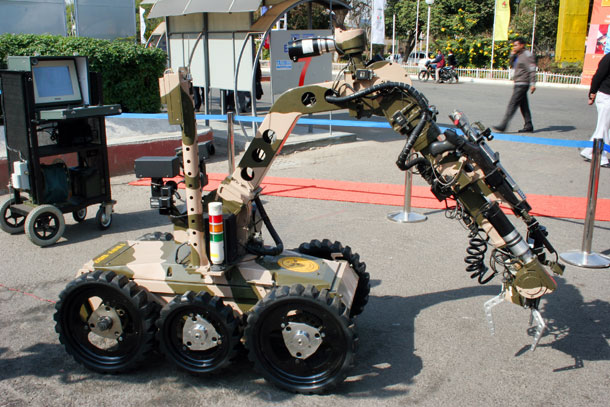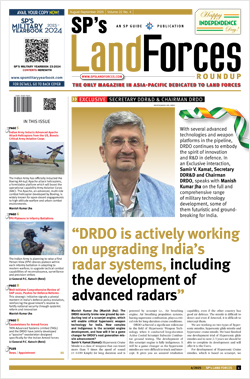INDIAN ARMED FORCES CHIEFS ON OUR RELENTLESS AND FOCUSED PUBLISHING EFFORTS

The insightful articles, inspiring narrations and analytical perspectives presented by the Editorial Team, establish an alluring connect with the reader. My compliments and best wishes to SP Guide Publications.

"Over the past 60 years, the growth of SP Guide Publications has mirrored the rising stature of Indian Navy. Its well-researched and informative magazines on Defence and Aerospace sector have served to shape an educated opinion of our military personnel, policy makers and the public alike. I wish SP's Publication team continued success, fair winds and following seas in all future endeavour!"

Since, its inception in 1964, SP Guide Publications has consistently demonstrated commitment to high-quality journalism in the aerospace and defence sectors, earning a well-deserved reputation as Asia's largest media house in this domain. I wish SP Guide Publications continued success in its pursuit of excellence.
- Appointments Committee of Cabinet approves one-month extension in service of Chief of the Army Staff
- Prime Minister witnesses 'Bharat Shakti' – a Tri-Services Firing and Manoeuvre Exercise in Pokhran, Rajasthan
- Interim Defence Budget 2024-25 — An Analysis
- Union Defence budget 2024
- Indian Army: In quest of greater firepower and policy recommendations for gaps
- Indian Army Annual Press Conference 2024
- Tata Boeing Aerospace Delivers 250 AH-64 Apache Fuselages, Manufactured in India
RoboSen is good — But we have miles to go
 |
By Lt. General P.C. Katoch (Retd) Former Director General of Information Systems, Indian Army |

DRDO has just unveiled RoboSen (short for 'Robot Sentry'). Its employability is for guarding a house, office or industrial unit. It can move around the premises, take photographs of all suspicious objects and movement, enabling law enforcement agencies to act, as and when required. Premises can be monitored in real time for effective surveillance and protection. RoboSen is an intelligent mobile robot with wireless links; while it operates in the open, the operator control unit is kept inside the house or premises. RoboSen can be commanded to move autonomously along a predefined path or controlled or controlled by a joystick while providing continuous feedback. RoboSen senses its environment using GPS, stabilized digital compass, and laser range finders, which help to navigating a path and planning algorithms in avoiding obstacles as it patrols a campus. DRDO has also developed 'Sarp' (short for 'Snake Robot') that can crawl everywhere with 14 active joints capable of lateral undulation, side winding and rolling gaits — just like a snake. According to a DRDO publication available at the 104th session of the Indian Science Congress held at Tirupati in early January 2017, these robots are equipped with ultrasonic sensors for obstacle detection and avoidance, adding, When you have a robot sentry and snake robot, why not think of a 'climbing robot' to scale walls vertically. The DRDO's climbing robot is a miniature-tracked robot capable of climbing vertical walls with an onboard colour camera for video feedback. The DRDO publication goes on to say intelligent mobile robotics for defence has constantly progressed through indigenous synergies in diverse multidisciplinary technologies; "Extrinsically, it has been driven by the current military scenario which demands unmanned systems with the ability to operate in an autonomous or semi- autonomous mode, under varied environmental conditions and terrain". And that intelligence and mobility are critical enablers for unmanned systems targeted for military operations.
RoboSen is good even as it came a decade after Sarp. But then DRDO has been developing other robots as well, like 'MARS' (Mobile Autonomous Robot System) which is a rugged vehicle looking like golf cart with green armour. Then there is 'Daksh' which is an electrically powered and remotely controlled robot used for locating, handling and destroying hazardous objects safely. How much time and money was spent on these by DRDO and whether these were invented from the scratch (reinventing the wheel) is not known but these have been available on the world market for many years and simple reverse engineering could have saved both time and money. DRDO has also developed Robo-Con that can sniff 'secularity' of an individual. Whether this was a political requirement or a DRDO initiative is not known but definitely more focus is required on military applications of robotics and artificial intelligence.
In 2006, it was announced that India will be pursuing technologies for developing a robotic army. Republic of Korea has been working on 'Killbots Army'. Technological advances enable the developers to build new systems for more tasks. In the US, an unmanned Humvee has been driven around at a speed of 56 kmph without deviating from its planned route. Such capability would have multiple applications, saving human costs and lives. Obviously such platforms would be fitted with cameras and weaponsl. Such smaller robots of the size of a golf cart (Gladiator — carrying a machine gun, rockets and non-lethal weapons) have already been developed that can be controlled by PlayStation video game controller or software plug-ins, allowing semi-automatic and fully autonomous modes. Then is the medial robot 'Bloodhound' (improved version of the 'packbot') which can locate wounded soldiers, checking vital functions and administer morphine. US has already produced a working automated sentry gun and is currently developing it further for commercial and military use. The US Army has also developed Autonomous Rotorcraft Sniper System consisting of a remotely operated sniper rifle attached to an unmanned autonomous helicopter intended for use in urban combat or other missions requiring deployment of snipers. Similarl to ground robots, USVs and UAVs are also being researched further incorporating weapons and surveillance devices. The Chinese military envisions its drone swarms scouting battlefields, guiding missile strikes and overwhelming the enemy defences through sheer numbers. China's military-industrial complex has established vide array of indigenous drones to accomplish these goals. China has also successfully tested hypersonic platforms. We must optimize robotics focusing on R&D to win future conflicts, optimizing public-private partnership. Enhanced defence partnerships with the US and Japan should provide necessary impetus.
Photo Credit: SP Guide Pubns





